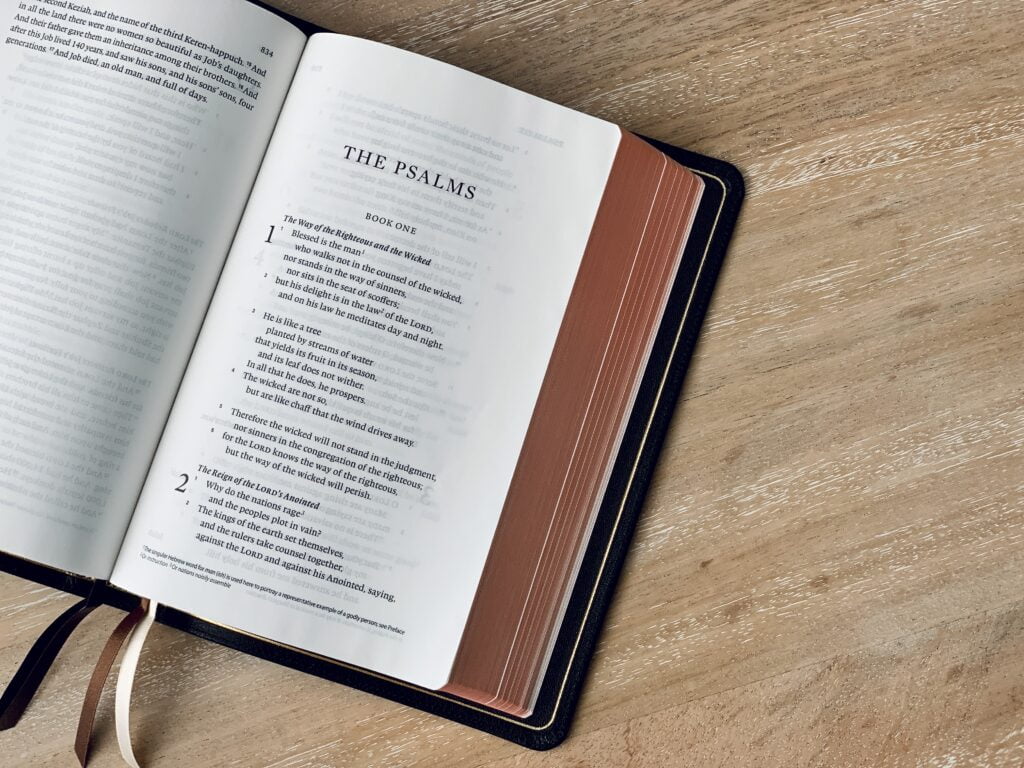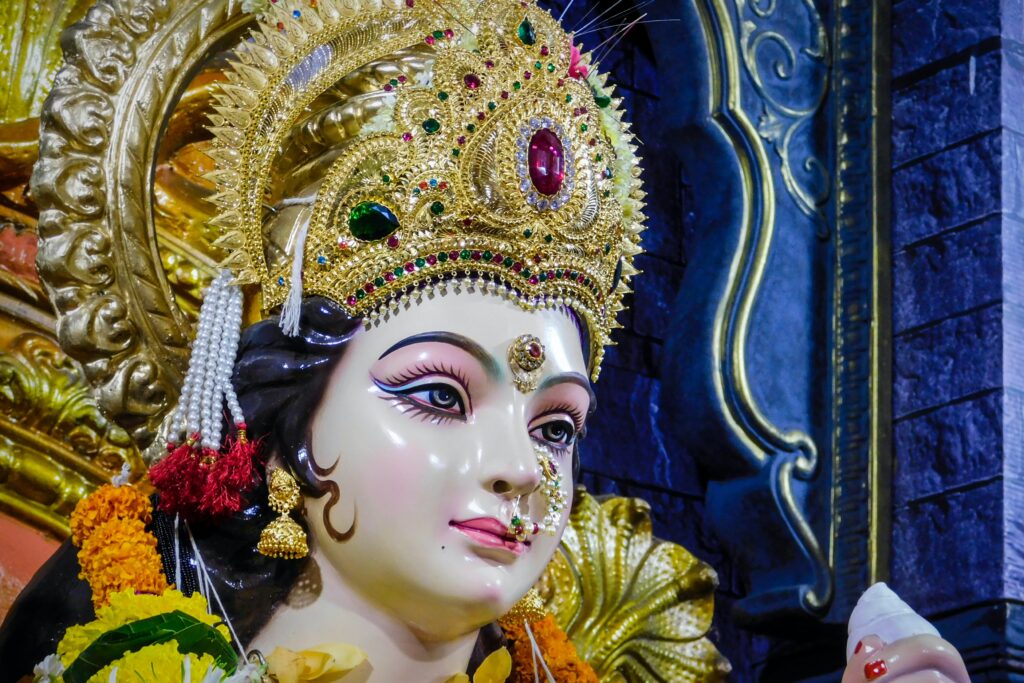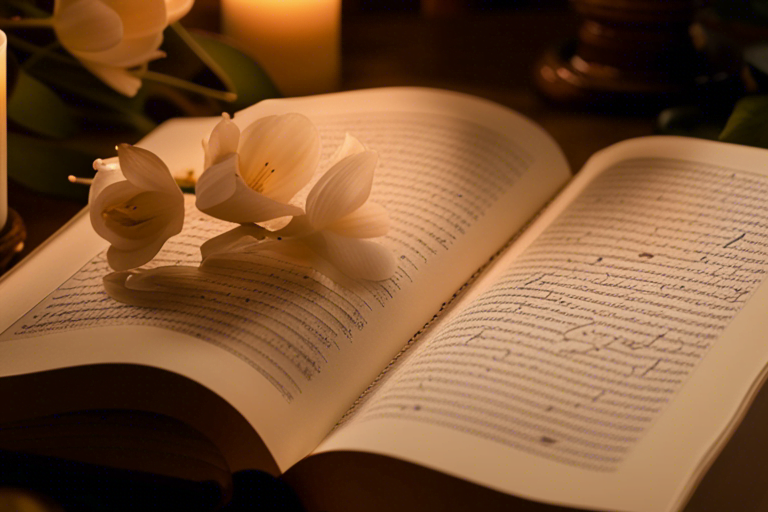As I venture into the enchanting world of religious poems, I am captivated by the deep emotions and profound insights they hold. In the fast-paced digital era, many of us yearn for solace and understanding, and religious poetry offers a glimpse into the depths of the human spirit. These soulful verses not only provide comfort and inspiration but also bridge the gap between psychology and spirituality. Join me on a journey where we explore the transformative power of religious poems, uncovering the wisdom and healing they can offer to our lives.

Exploring the Depth of Religious Poems
Religious poems have long been recognized as a powerful form of expression that delves deep into the human experience and explores the realms of faith, spirituality, and the divine. Through the use of poetic language, imagery, and symbolism, religious poems offer a unique and profound insight into the intricacies of religious beliefs, the nature of existence, and the relationship between the individual and the divine. In this article, we will explore the significance, historical context, language and structure, themes and motifs, interpretation and analysis, comparative analysis, spiritual healing, personal growth, contemporary influence, digital age impact, and the beauty and power of religious poems.
Understanding the Significance of Religious Poems
Religious poems hold a significant place in the literary and cultural traditions of societies around the world. Whether it is through the sacred texts of major world religions or the verses of individual spiritual seekers, religious poems serve as a powerful means of conveying deep spiritual truths, exploring the mysteries of existence, and fostering a sense of connection to the divine. These poems often elicit a range of emotions, from awe and reverence to joy and contemplation, making them a vital part of religious and spiritual practices.
Examining the Historical Context of Religious Poems
To fully appreciate and understand religious poems, it is important to examine their historical context. These poems are often rooted in specific religious traditions and are influenced by the cultural, social, and political dynamics of the time in which they were written. By exploring the historical context of religious poems, we can gain insights into the religious beliefs, values, and practices that shaped the lives of people throughout history and continue to shape our understanding of spirituality today.
Analyzing the Language and Structure of Religious Poems
Religious poems employ a variety of linguistic devices and poetic techniques to convey their deeper meanings. From intricate metaphors and vivid imagery to rhythmic patterns and meter, the language and structure of religious poems play a crucial role in evoking emotions, capturing the imagination, and conveying complex spiritual concepts. By analyzing the language and structure of religious poems, we can gain a deeper appreciation for the artistry and craftsmanship of these works and unravel the layers of meaning they hold.
Exploring the Themes and Motifs in Religious Poems
Religious poems often revolve around universal themes and motifs that resonate with people across different cultures and belief systems. These themes can include love, devotion, redemption, salvation, mortality, and the nature of God or the divine. By exploring the themes and motifs in religious poems, we can gain insights into the shared human experiences and the fundamental questions that have occupied the minds of poets and spiritual seekers throughout history.
Religious Poems: A Source of Spiritual Inspiration
The Role of Religious Poems in Personal Spiritual Journeys
Religious poems have the power to inspire and guide individuals on their personal spiritual journeys. Whether through the exploration of religious teachings, the expression of personal experiences and struggles, or the evocation of a sense of wonder and awe, these poems offer solace, encouragement, and a deep connection to the divine. They can serve as a source of inspiration, a reservoir of wisdom, and a reminder of the transcendent nature of existence.
Finding Guidance and Comfort in Religious Poems
Religious poems provide a source of guidance and comfort for individuals facing life’s challenges and seeking answers to the deeper questions of existence. They offer solace in times of grief, courage in times of uncertainty, and hope in times of despair. Through their powerful and evocative language, religious poems offer a refuge for the soul, reminding us of the eternal truths that underpin our lives and offering a sense of peace and comfort in difficult times.
The Transformative Power of Religious Poems
The reading and contemplation of religious poems can have a transformative effect on individuals. These poems have the capacity to awaken a sense of spiritual awareness, deepen one’s understanding of the divine, and foster a sense of inner peace and contentment. Through their exploration of universal spiritual themes and their ability to evoke profound emotions, religious poems can bring about personal transformation, leading individuals to develop a deeper connection to their spirituality and a greater sense of purpose and meaning in life.

Religious Poems as a Reflection of Faith and Belief
Examining the Influence of Religion on Poetic Expression
Religious belief systems have influenced the way poets express their thoughts, emotions, and experiences. The influence of religion on poetic expression can be seen in the language, imagery, and themes employed in religious poems. Whether it is the use of sacred texts, religious symbols, or the exploration of religious teachings, the influence of religion on poetic expression adds depth, richness, and imbues the poems with a sense of reverence and spirituality.
The Connection Between Religious Beliefs and Poetic Themes
Religious beliefs often shape the themes explored in religious poems. The concepts of divinity, the nature of the soul, the afterlife, and the relationship between humans and the divine are common themes that emerge in religious poems. By examining the connection between religious beliefs and poetic themes, we can gain insights into the ways in which spirituality informs and shapes human creativity, offering a deeper understanding of the complex relationship between faith and artistic expression.
Exploring the Use of Symbolism and Metaphor in Religious Poems
Religious poems often employ symbolism and metaphor to convey abstract ideas and spiritual truths. Through the use of symbols and metaphors, poets can transcend the limitations of language, evoke deeper emotions, and communicate complex concepts that are beyond the grasp of rational thought. The use of symbolism and metaphor in religious poems invites readers to engage in a contemplative and introspective journey, encouraging them to explore the deeper meanings and significance behind the words.
Interpreting and Analyzing Religious Poems
Approaches to Interpreting Religious Poems
Interpreting religious poems requires an understanding of the cultural, historical, and religious contexts in which they were written. There are several approaches to interpreting religious poems, including a close reading of the text, an analysis of the poet’s biography and influences, and an exploration of the broader religious and philosophical traditions that inform the poem. By adopting different interpretive approaches, readers can gain multiple perspectives and insights into the meaning and significance of religious poems.
Unpacking the Layers of Meaning in Religious Poems
Religious poems often contain multiple layers of meaning, which can be unravelled through careful reading and analysis. These layers may include literal, metaphorical, allegorical, and symbolic meanings that invite readers to delve deeper into the text and engage with the poem on various levels. Unpacking the layers of meaning in religious poems allows readers to discover hidden truths, explore the mysteries of existence, and develop a deeper appreciation for the complexity and richness of these works.
Tools and Techniques for Analyzing Religious Poems
Analyzing religious poems requires the use of specific tools and techniques that help readers uncover the underlying meanings and themes. These tools and techniques can include close reading, identifying patterns and motifs, analyzing the use of language and imagery, and comparing the poem with other works within the same religious or literary tradition. By employing these tools and techniques, readers can gain a deeper understanding of religious poems and the ideas and emotions they seek to convey.

Comparative Analysis of Religious Poems
Exploring Different Religious Traditions Through Poetry
Comparative analysis of religious poems allows readers to explore the similarities and differences between different religious traditions. By examining poems from various religious traditions, readers can gain insights into the unique perspectives, beliefs, and practices of different cultures and religions. This comparative analysis can deepen our understanding of the universal human experiences addressed in religious poems and highlight the common threads that connect us all.
Identifying Common Themes and Motifs Across Religious Poems
Despite the diversity of religious traditions, there are often common themes and motifs that emerge in religious poems across different cultures and belief systems. Love, redemption, spiritual growth, and the search for meaning and purpose are just a few examples of the themes that transcend religious boundaries and resonate with people from all walks of life. Identifying these common themes and motifs allows readers to recognize the shared human experiences and spiritual beliefs that underpin religious poetry.
Examining the Cultural and Historical Influences on Religious Poetic Traditions
The cultural and historical context in which religious poems are written plays a significant role in shaping the poetic traditions of different cultures and religions. By examining the cultural and historical influences on religious poetic traditions, readers can gain insights into the social, political, and religious dynamics that have shaped these traditions over time. This examination also allows readers to appreciate the diversity and richness of religious poetry and understand how it reflects the unique characteristics of different cultures and historical periods.
Religious Poems as a Medium for Spiritual Healing
The Therapeutic Power of Religious Poems
Religious poems have a therapeutic power that can bring healing and comfort to individuals facing emotional and spiritual challenges. Through their use of language, imagery, and symbolism, religious poems can evoke a sense of peace, inspire hope, and provide solace in times of grief and loss. The meditative and contemplative nature of religious poems allows individuals to engage in self-reflection, find meaning in difficult experiences, and experience a sense of transcendence that can contribute to emotional and spiritual healing.
Using Religious Poems for Meditation and Reflection
Religious poems can be used as a tool for meditation and reflection, offering individuals the opportunity to connect with their inner selves and the divine. By reading and contemplating religious poems, individuals can enter into a state of focused awareness and engage in a deep exploration of their thoughts, emotions, and spiritual experiences. This practice can lead to a state of peace, clarity, and a greater sense of connection to the divine.
Healing and Transformation Through Engaging with Religious Poetry
Engaging with religious poetry can bring about healing and transformation in individuals’ lives. By immersing themselves in the language, imagery, and themes of religious poems, individuals can tap into their own inner wisdom, gain insights into their spiritual journey, and experience a deep sense of connection to the divine. Through this engagement, individuals may find healing from past traumas, discover new spiritual insights, and undergo personal transformation that leads to a greater sense of wholeness and well-being.
The Intersection of Religious Poetry and Personal Growth
Religious Poems as Catalysts for Self-Discovery and Self-Reflection
Religious poems serve as catalysts for self-discovery and self-reflection, offering individuals the opportunity to explore their own beliefs, values, and spiritual experiences. Through reading and contemplating religious poems, individuals can gain a deeper understanding of themselves, their relationship with the divine, and their place in the world. This self-discovery and self-reflection can lead to personal growth, increased self-awareness, and a greater sense of purpose and meaning in life.
The Role of Religious Poetry in Spiritual Development
Religious poetry plays a vital role in the spiritual development of individuals. By engaging with religious poems, individuals can cultivate their spiritual awareness, deepen their connection to the divine, and develop a greater understanding of their own spiritual journey. The exploration of religious poetry can provide individuals with guidance, inspiration, and a framework for their spiritual growth, leading to a more meaningful and fulfilling spiritual life.
Using Religious Poems as Tools for Personal Transformation
Religious poems can be used as tools for personal transformation, enabling individuals to transcend their limitations, overcome challenges, and expand their consciousness. Through their exploration of universal spiritual themes and their ability to evoke deep emotions, religious poems can inspire individuals to let go of old patterns, beliefs, and attachments that no longer serve them, and embrace new ways of thinking and being. By using religious poems as tools for personal transformation, individuals can embark on a journey of self-discovery, spiritual growth, and personal fulfillment.
The Influence of Religious Poems on Contemporary Literature
Examining the Legacy of Religious Poetry in Modern Literature
Religious poetry has had a significant influence on contemporary literature, shaping the themes, styles, and perspectives of modern poets. The legacy of religious poetry can be seen in the exploration of spiritual themes, the use of religious symbolism and imagery, and the incorporation of religious teachings and traditions into contemporary poetic works. By examining the legacy of religious poetry in modern literature, readers can gain insights into the ongoing relevance and impact of religious poems on the literary world.
The Evolution of Religious Poetic Forms and Styles
Religious poetry has evolved over time, adapting to the changing literary trends and cultural dynamics of different periods. From ancient epics and hymns to modern free verse and performance poetry, religious poets have experimented with various forms, structures, and styles to convey their spiritual insights and experiences. Examining the evolution of religious poetic forms and styles allows readers to appreciate the diversity and creativity of religious poetry and understand how it continues to evolve and adapt to the needs and sensibilities of contemporary readers.
Contemporary Poets Drawing Inspiration from Religious Traditions
Contemporary poets often draw inspiration from religious traditions, exploring spiritual themes and ideas in their works. Whether through direct references to religious texts and symbols or through the exploration of universal spiritual concepts, contemporary poets infuse their poems with the wisdom and insight derived from religious traditions. By drawing inspiration from religious traditions, contemporary poets contribute to the ongoing dialogue between spirituality and poetic expression, bringing ancient wisdom into modern literary forms and styles.
Religious Poems in the Digital Age
The Accessibility of Religious Poems Online
In the digital age, religious poems have become more accessible than ever before. Online platforms and digital archives offer a wealth of religious poems from various traditions, allowing individuals to explore and engage with these works from anywhere in the world. The accessibility of religious poems online enables individuals to deepen their spiritual practice, find inspiration, and connect with the wisdom of religious traditions across time and space.
Digital Platforms for Sharing and Discussing Religious Poetry
Digital platforms have also provided spaces for individuals to share and discuss religious poetry. Online communities, forums, and social media platforms offer a space for poets, scholars, and enthusiasts to connect, share their own poems, and engage in meaningful discussions about religious poetry. These digital platforms foster a sense of community, encourage collaboration, and contribute to the ongoing exploration and appreciation of religious poetry in the digital age.
The Impact of Technology on the Creation and Distribution of Religious Poetry
Technology has had a profound impact on the creation and distribution of religious poetry. The advent of digital tools and software has made it easier for poets to write, edit, and publish their works, enabling them to reach a wider audience. Additionally, digital platforms and online publishers have made it possible for religious poems to be distributed globally, transcending geographical and cultural boundaries. The impact of technology on the creation and distribution of religious poetry has democratized the process, allowing individuals from diverse backgrounds and experiences to participate in the poetic dialogue.
Appreciating the Beauty and Power of Religious Poems
The Aesthetics of Religious Poetry
Religious poetry is not only rich in meaning and spiritual depth but also possesses its own unique aesthetic qualities. The musicality of language, the rhythm, the meter, and the imagery employed in religious poems contribute to their beauty and power. The aesthetics of religious poetry evoke emotions, captivate the imagination, and transport readers to a realm beyond the mundane, allowing them to experience a sense of awe and reverence.
Emotional and Spiritual Impact of Religious Poems
Religious poems have a profound emotional and spiritual impact on readers. The evocative language, the exploration of profound spiritual themes, and the engagement with the divine can elicit a wide range of emotions, from joy and inspiration to sadness and contemplation. Religious poems have the power to stir the soul, awaken dormant emotions, and bring about a sense of spiritual awakening and transformation.
Recognizing the Universal Appeal of Religious Poetic Expression
Religious poetic expression transcends specific religious beliefs and traditions, appealing to individuals from all walks of life. The universal themes, the exploration of the human condition, and the search for transcendence and meaning resonate with individuals across cultures, belief systems, and spiritual backgrounds. Recognizing the universal appeal of religious poetic expression allows us to appreciate the diversity of human experiences and the deep spiritual longing that unites us all.
In conclusion, religious poems hold a profound significance in the realm of spiritual and literary expression. Through their exploration of universal themes, use of symbolism and metaphor, and their ability to evoke deep emotions, religious poems invite readers on a transformative journey of spiritual exploration and self-discovery. Whether in the context of personal spiritual growth, the understanding of religious beliefs and traditions, or the appreciation of poetry as an art form, religious poems continue to inspire, guide, and touch the hearts and souls of individuals across time and cultures.

